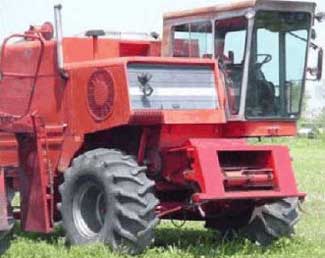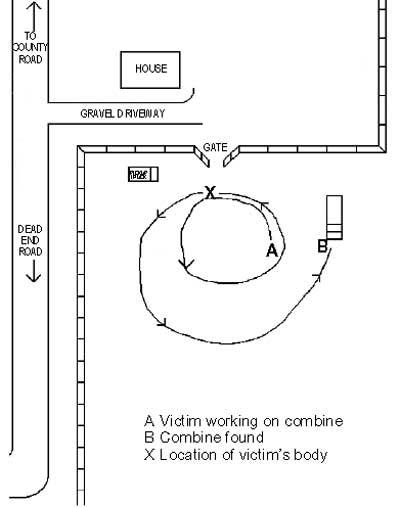A Farmer Was Killed When He Was Run Over By A Combine

OKFACE Report #03-OK-032-01
SUMMARY
A 60-year old farmer died on May 15, 2003 from injuries received when he was run over while servicing a combine. Scene conditions indicated that the combine was left running while the victim attempted to add hydraulic fluid. During this maintenance, the combine suddenly moved forward. The victim was run over by the rear tire. After circling the field, the combine ran over the victim a second time. There were no witnesses to the incident. The decedent’s wife found him after 9:00 p.m. that evening and reported the incident to local authorities. The victim was pronounced dead at the scene.
Oklahoma Fatality Assessment and Control Evaluation (OKFACE) investigators concluded that to prevent similar occurrences, farm equipment owners/operators should:
- Follow manufacturer’s recommendations and safe work practices when operating farm equipment.
- Inspect work areas and equipment before performing a task to identify actual and potential hazards and determine methods of control.
- Ensure that personnel maintaining or servicing farm equipment are trained, competent to perform the required work, and practice proper farm safety procedures.
INTRODUCTION
A 60-year old farmer died on May 15, 2003 from injuries received when he was run over by a combine (Figure 1). The victim was apparently replenishing a low hydraulic fluid level with the combine’s engine running. OKFACE investigators reviewed the Medical Examiner’s report, death certificate, sheriff’s report, and newspaper clippings related to the incident. While conducting the site survey, OKFACE investigators interviewed the investigating law enforcement officer, who was a lifelong friend of the victim. The victim was working alone in a remote location; there were no witnesses to the incident.
 |
| Figure 1. Combine model involved in incident |
The decedent, who was raised on a farm and owned his farm for 35 years, had extensive experience using a variety of farm machinery and equipment. The victim had operated a combine numerous times and owned the one involved in the incident for several years. The amount of safety training the farmer had is unknown; however, the investigating officer, who had known the decedent his entire life, could not remember any prior severe injuries or events.
Stop the engine before doing any checks, adjustments, repairs, lubricating or clearing any obstruction, or when leaving the cab or operating platform for any reason.
INVESTIGATION
On the morning of May 15, 2003, approximately 8:00 a.m., the victim was outside working alone on his property when his wife last saw him before she left for the day. The decedent’s house and farm are the only properties located on a dead end road set well back from the main county road. It was a clear morning and the ground was dry.
Sometime during the day, the decedent started working with his combine in a field located across from the front of the house (Figure 2). Apparently, his combine was low on hydraulic fluid and he was attempting to add more at the time of the incident. It is not known what time he started servicing the combine, but it was left running during the maintenance. It is also not known if the combine gear selector was left in drive or slipped into drive, but when the farmer began to fill the hydraulic fluid, the pressure built up in the lines and engaged the hydrostatic transmission, causing the combine to move forward. At this point, the victim was either thrown from the combine or fell while attempting to catch and board the moving machinery. He was apparently dragged a short distance and then run over by the rear wheel. The unmanned combine continued moving and made a large counter-clockwise circle through the field, eventually returning to where the victim was lying. The combine ran over the victim again, this time with the front tire, and continued traveling. Upon completing a second larger circle, the combine crashed into a two-ton wheat truck parked in the same field. Apparently, the combine’s engine died on impact with the truck; however, the investigating officer noted that he was able to restart it with ease.
 |
| Figure 2. Diagram of the scene |
At approximately 9:00 p.m., the victim’s wife returned home. Visibility was poor due to evening darkness and an approaching thunderstorm. She looked for her husband in the house and outside around the yard before noticing the victim’s pickup and machinery in the wheat field. After entering the field through a gate across from the front of the house, she observed her husband’s body lying unresponsive on the ground. She ran back to the house and called a relative, who then called 911. Emergency medical services and a deputy sheriff arrived a few minutes later. The victim was pronounced dead at the scene and transported to a local funeral home.
CAUSE OF DEATH
The Medical Examiner listed the cause of death as multiple trauma.
RECOMMENDATIONS
Recommendation # 1: Employers should follow manufacturer’s recommendations and safe work practices when operating farm equipment.
Discussion: Performing service on an unsecured combine with the engine running was the underlying cause of this fatal incident. The combine would not have moved forward if the engine had not been running. Manufacturer’s recommendations for farm equipment are generally that no servicing or maintenance be attempted on equipment that is running. All power driven attachments should be disengaged as well to prevent hazardous, inadvertent movement. Parking or emergency type brake systems should be applied before any service or maintenance is performed. For example, when performing service or maintenance on a farm tractor, the vehicle should be secured with attachments in a neutral position, the gear selector in park or neutral, the parking brake on, and the key in the off position. Removal of the key is recommended when possible [Occupational Safety and Health Administration (OSHA) Standards for Agriculture, Subpart C, Appendix A, Employee Operating Instruction].
According to the OSHA Standard for Agricultural Equipment, 29 CFR 1928.57(a)(6)(iii), the employee should “stop [the] engine, disconnect the power source, and wait for all machine movement to stop before servicing, adjusting, cleaning, or unclogging the equipment, except where the machine must be running to be properly serviced or maintained, in which case the employer shall instruct employees as to all steps and procedures which are necessary to safely service or maintain the equipment.” Adding hydraulic fluid is not an operation that requires the engine to remain running on a combine.
Recommendation #2: Employers should inspect work areas and equipment before performing a task to identify actual and potential hazards and determine methods of control.
Discussion: Employers should develop an inspection process to eliminate or control hazards before employees are allowed to work in the area, including service and maintenance operations. If the combine had been inspected to ensure that it was properly secured so it could not move, the incident might have been prevented. Even when working alone or on small family farms where there likely are no formal written procedures, it is important to assess the working environment and the equipment in use to prevent hazardous situations. This inspection should include considering the proper functioning of machinery, in addition to safe working practices by the operator.
Recommendation # 3: Employers should ensure that personnel maintaining or servicing farm equipment are trained, competent to perform the required work, and practice proper farm safety procedures.
Discussion: The safety procedures for farm equipment are usually listed in the owner’s manual and sometimes are found posted on or around the machinery itself. Employers should ensure that the operator is familiar with recommended safety procedures and should maintain equipment manuals and manufacturer safety information for future reference. Before operating or performing service or maintenance on any piece of equipment, the employee should review this information. The OSHA standard 29 CFR 1928.57(a)(11) provides the following guidelines for servicing and maintenance procedures: “Whenever a moving machinery part presents a hazard during servicing or maintenance, the engine shall be stopped, the power source disconnected, and all machine movement stopped before servicing or maintenance is performed, except where the employer can establish that [1928.57(a)(11)(i)] the equipment must be running to be properly serviced or maintained; [1928.57(a)(11)(ii)] the equipment cannot be serviced or maintained while a guard or guards otherwise required by this standard are in place; and [1928.57(a)(11)(iii)] the servicing or maintenance can be safely performed.”
The nature of farming equipment is that the owner’s manuals and other documentation often are not available with the equipment, particularly in the case of used or aged equipment. Sometimes it has been lost or damaged beyond legibility due to the nature of the work. Owners/employers should maintain this information and make it available to all employees who might utilize the machine or equipment. If it is not available, contact the manufacturer in order to obtain another copy.
REFERENCES
- National Agriculture Safety Database Web site: http://www.nasdonline.org/index.htmlexternal icon. (Link updated 8/5/2009)
- Occupational Safety and Health Administration, 29 CFR 1928 Subpart C, Appendix A, Employee Operating Instruction.
- Occupational Safety and Health Administration, 29 CFR 1928.57, Guarding of Farm Field Equipment, Farmstead Equipment, and Cotton Gins.
- Oklahoma Cooperative Extension web site: http://pods.dasnr.okstate.edu/docushare/dsweb/Get/Document-2171/BAE09417web.pdfpdf iconexternal icon. (Link updated 8/5/2009)
The Oklahoma Fatality Assessment and Control Evaluation (OKFACE) is an occupational fatality surveillance project to determine the epidemiology of all fatal work-related injuries and identify and recommend prevention strategies. FACE is a research program of the National Institute for Occupational Safety and Health (NIOSH), Division of Safety Research.
These fatality investigations serve to prevent fatal work-related injuries in the future by studying the work environment, the worker, the task the worker was performing, the tools the worker was using, the energy exchange resulting in injury, and the role of management in controlling how these factors interact.
To contact Oklahoma State FACE program personnel regarding State-based FACE reports, please use information listed on the Contact Sheet on the NIOSH FACE website. Please contact In-house FACE program personnel regarding In-house FACE reports and to gain assistance when State-FACE program personnel cannot be reached.
Back to NIOSH FACE Web
